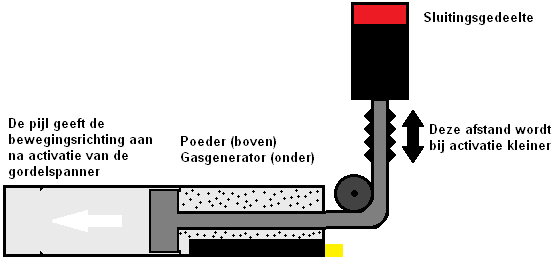Subjects:
- General
- Force of a collision to a stop
- Delay Sensors
- Airbag modules
- Steering and passenger airbag
- coil spring
- side airbag
- Curtain airbag
- Knee airbag
- Belt tensioner
General:
An airbag is an additional protection system. Along with seat belts, airbags are designed to protect the occupant(s) of a car if it is involved in a collision. Almost every modern car has one or more airbags. These are the airbags on the driver's side in the steering wheel and on the passenger side in the dashboard. More advanced models also have side airbags in the headliner, doors or seats.
The airbags are activated when the vehicle has a deceleration greater than 12 m/s². The crash sensors register the deceleration and transmit it to the airbag control unit. The control unit controls the airbags, which fully inflate within milliseconds.

In addition to the airbags, the control unit controls more safety components to best protect the vehicle's occupants. Not all components are controlled simultaneously. The time is programmed in the control unit software. Depending on the intensity of the collision, the following safety components are activated:
- In the event of a minor collision: nothing happens;
- In the event of a slightly more serious collision: the belt tensioners are activated. If the vehicle is equipped with seat occupancy detection, the co-driver's belt tensioner is only activated when the sensor registers a person on the seat;
- In the event of an even more serious collision: Airbag is activated. Modern systems are equipped with a two-stage airbag.
- With a slight delay in which the airbag is deployed, the time between the first and second phase is 100 ms.
- With a greater delay, the time between the first and second phase is shorter.
- The first and second phase can even take place simultaneously if the delay is very large.
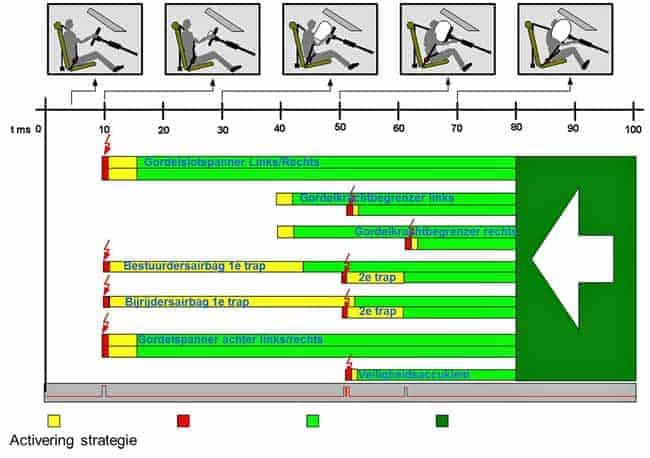
Delay Sensors:
The deceleration of the vehicle is measured by deceleration sensors. If the deceleration exceeds the maximum braking deceleration of the car, it must be caused by a collision. When the airbag sensors measure such a large deceleration that is higher than 12 meters per second, these sensors send a signal to the airbag control unit. This in turn will activate the airbags. An average passenger car with good brakes has a braking deceleration of between 5 and 7 meters per second, sports cars can achieve a deceleration of up to 8 meters per second. This means that you can never achieve the maximum braking deceleration of 12 m/s by braking. Even when driving at low speed against a pole or wall, this delay is not always achieved and the airbags will therefore not be activated.
Most newer deceleration sensors are integrated into the control unit, but sometimes the sensors are also mounted separately on the body panels. They respond to mass inertia in 1 direction, so it is important that the sensor is mounted in the right way (so not upside down, because then the airbags will not be activated in a collision). Delay sensors can be both electronic and electromechanical. A Poezo crystal is mounted in an electronic deceleration sensor. When a force is applied to a Poezocrystal, a voltage is generated in it. The force acting on the sensor is caused by the deceleration in the event of a collision. The height of the generated voltage depends on the force of the collision.
The system can also be equipped with an electromechanical deceleration sensor, which closes mechanically at a certain force. An electronic contact is closed at that time. The generated signal is then sent to the control unit. When both the electronic sensor with Poezocrystal and the safety switch give a signal to the control unit, the control unit activates the airbags in the passenger compartment.
Airbag modules:
Separate airbag modules are provided with each steering wheel/passenger/and side airbag. When the control unit supplies voltage to the airbag modules, the airbag modules will deploy. An explosion follows, releasing a large amount of gas that consists of 99% nitrogen. This gas completely inflates the airbag. An airbag deploys at a high speed of approximately 300 km/h. After the airbag has inflated, it should also deflate very quickly for safety reasons. There are large holes on the back of the airbag modules, through which the hot gas can escape.
Airbag Control Unit:
The airbag control unit directs the airbag modules to deploy the airbag. Another job of the airbag control unit is to deploy the airbags only in the passenger seats. There is a special sensor mat under the seat cover that registers whether someone is sitting on the seat. If this is the case, the airbag control unit will also control that airbag. If no one is sitting on the seat, the airbag will not deploy. This helps considerably with cost savings, because an airbag is not cheap. As a safety measure, the airbag malfunction light is activated when there is a sensor mat malfunction.
There are also two-stage airbags, which deploy depending on the person's body weight. The previously mentioned sensor mat measures the weight. If this is low, stage 1 is activated. If the weight is above eg 100 kg, the 2nd stage is activated. The air volume in the bag is increased at the second stage, causing the bag to inflate more.
The control unit always applies a certain low voltage to the airbag and, by checking the resistance, can recognize whether the airbag is still present and in order. This check takes place four times per second. Therefore, if an airbag is removed, the control unit will recognize it and immediately illuminate the airbag malfunction light. This can happen when the ignition is turned on when there is any part of the system disassembled. For safety, the light will no longer go out until it is reset with the readout computer via the OBD system.
Steering wheel and passenger airbag:
The steering wheel airbag is located in the center of the steering wheel. In a head-on collision, it is completely inflated in a very short time. The purpose of this airbag is to cushion the forward moving occupant. After inflating, the airbag also deflates immediately, otherwise there is a risk of suffocation.
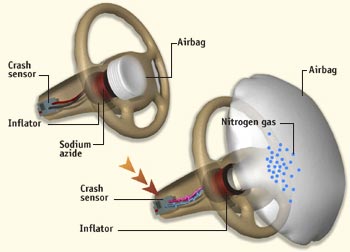
The driver's airbag has a capacity of about 35 liters, and the passenger airbag has a capacity of 65 liters. The passenger airbag has a larger capacity because the dashboard is further away from the seat.
The steering wheel and passenger airbags will not deploy in a side impact, vehicle rollover, rearward impact and when driving on rough terrain/curbs. These airbags only deploy in the event of a frontal collision.
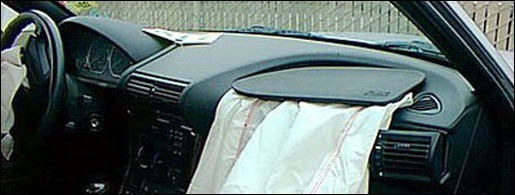
coil spring:
A special wire is required to connect the airbag in the steering wheel to the control unit. A normal wire could wear out after a long time with many steering. The wire is also called contact roll, coil spring or coil spring. The most common name of these three is coil spring. It is a long, wide, flat wire (or ribbon) coiled around the steering shaft. In this way, the extreme steering angle can easily be reached. When this coil spring is disassembled, pay close attention to the position in which it is disassembled. If the coil spring is turned before mounting, the spring will break during steering after mounting. The airbag light will come on immediately because no more voltage can be sent to the steering airbag. A coil spring may not be repaired after breaking, only replaced.
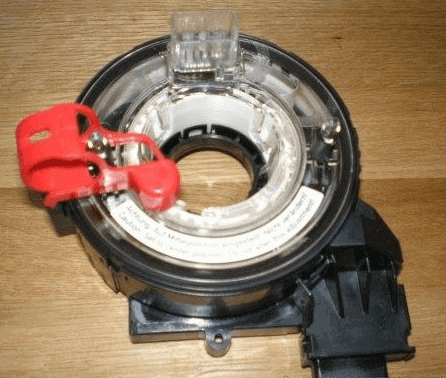
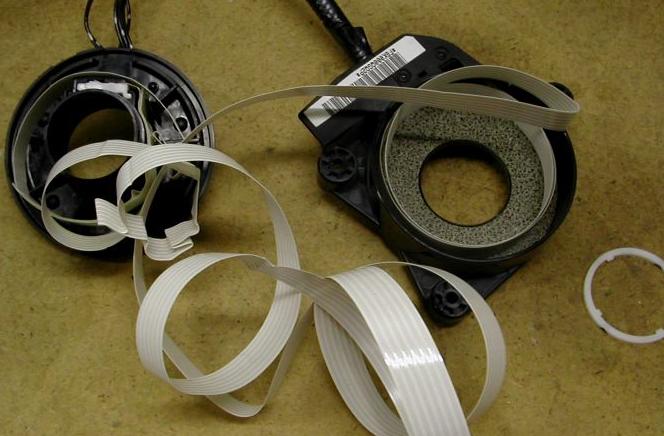
Side airbag:
Side airbags, also called door airbags or seat airbags, serve to protect the occupants against side collisions. This airbag can be located in the door as well as in the backrest of the seat. The upholstery of the door or the seat will tear with a specially prepared stitching seam.
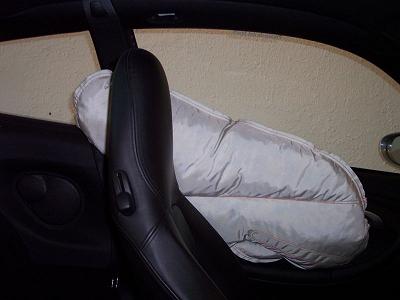
Curtain airbag:
The curtain airbag is mounted at the top of the headliner. In the event of a side impact, it inflates and protects both the front and rear passengers.
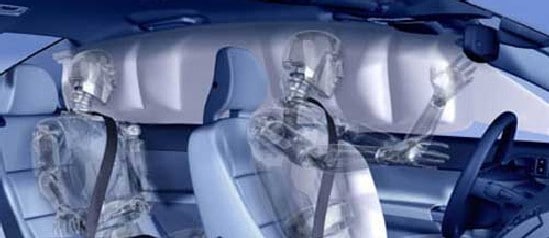
Knee airbag:
The knee airbag protects, as the name suggests, the knees in a frontal collision. Every year, a lot of injuries are sustained because the knees make a violent blow against the dashboard. These sturdy air cushions try to prevent that as much as possible. These airbags have been on the market for the least for a long time and are not yet widely used.
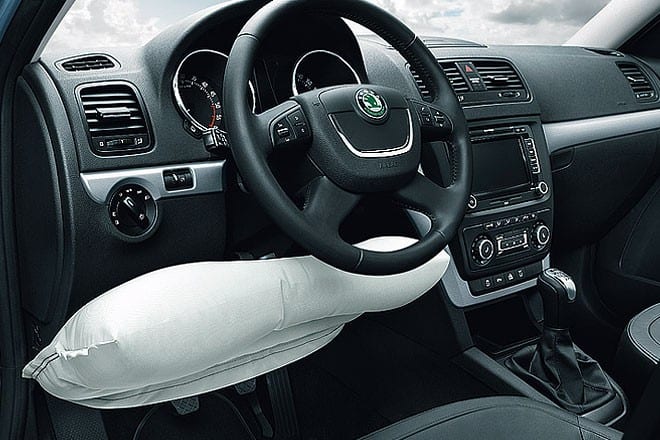
seat belt tensioners:
Safety systems are also often equipped with belt tensioners. The belt tensioners are also controlled by the airbag control unit. The operation of the belt tensioners with the tensioner on the closing section of the retractor is described on page Belt tensioner.
